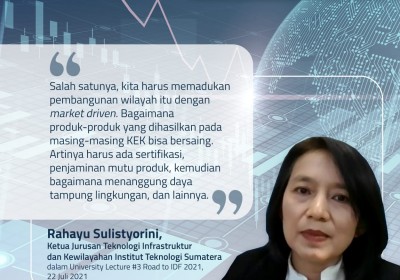Why The Construction of Industrial Zones Must Benefit a Region's Surroundings
August 10, 2021
JAKARTA – The island of Sumatra remains Indonesia's leading national energy production center. However, many regions on the island are mainly producers of raw energy materials, which need to be processed further in order to provide added value.
The construction and development of special economic zones (KEK) and industrial estates (KI) would help increase the added value and the economic growth of those regions.
However, the development of such zones could also bring in negative impacts to the surrounding environments and communities.
"That is why any attempts to construct industrial zones in these areas must be done in a market-driven sense: how can the goods produced in these zones benefit the surroundings? That means there needs to be clear and proper certification processes, product quality guarantees, and it must be clear how much the surrounding environment can bear the activity," the Sumatra Technological Institute's head of infrastructure and zoning technology studies Rahayu Sulistyorini explained during the University Lecture #3 Road to Indonesia Development Forum 2021 webinar on Thursday (22/7).
Rahayu added that the next focus should be developing the infrastructure of these strategic areas which is able to support the acceleration of the region's development. The emergence of priority development programs provides benefits for accelerating regional development, but on the other hand, it also can have a widening impact of inequality between regions, especially in non-priority areas.
The best solution to de-isolate areas from each other is to build adequate road and port infrastructure. The development of such accesses can be done by establishing connectivity networks to and from priority locations for the sake of regional development.
"So if we were to only focus development on one particular region, we wouldn't be able to see the full effects of it. It will only lead to economic disparity between regions. We all know that Sumatra has extensive toll roads but most of them are in the East. What about the West? The central regions? That has to be considered as well, and Bappenas cant do that alone. They must coordinate with the Transportation Ministry and the Manpower Ministry (KemenPUPR). We have to eliminate these disparity issues as soon as we can," she said.
The state and the interconnectivity of transportation infrastructure is also important when developing KEKs to tackle the problem, Rahayu added.
"When we're talking transport for these areas, we must consider intermodal methods. Intermodal systems are able to make KEK construction and operational processes of KEKs more efficient. This should be the first thing to consider when designing and determining locations to build the KEK itself".
Indonesia’s Research Institutions Supporting the Development of the Electric Vehicle Industry
Indonesian Muslim Fashion and Cosmetics IKMs Shine at Dubai World Expo 2020
Govt Steps Up UMKM Transformation Efforts in the Midst of Pandemic Slowdown
Govt Encourages Promotion of IKM Products in Digital Era
Government Begins Developing Maritime Training Center in Makassar
Tweets by IDDevForum
